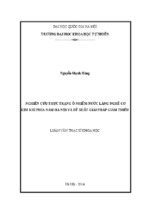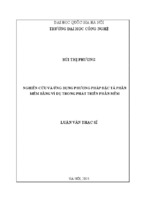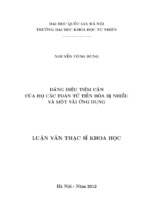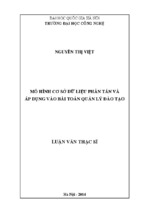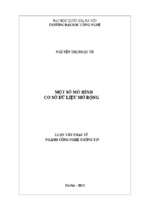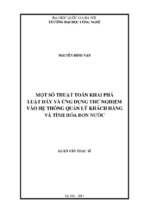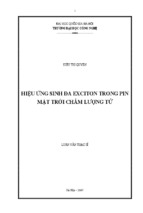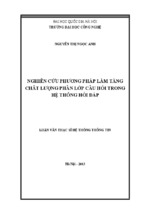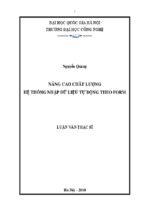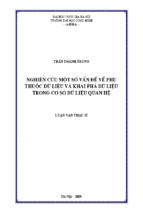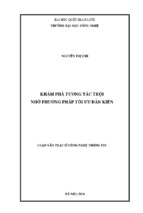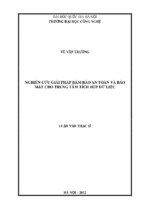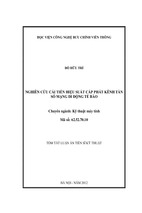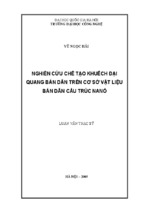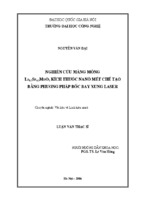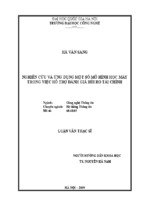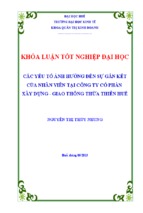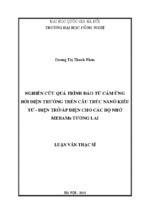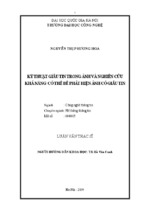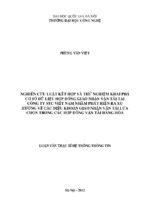VIETNAM NATIONAL UNIVERSITY OF HANOI
COLLEGE OF TECHNOLOGY
HOANG QUANG HUNG
FABRICATION AND INVESTIGATION ON
MICROSPHERE LASER BASED ON
ER-DOPED SILICA GLASS
Major: Nano Materials and Devices
Index:
M ASTER THESIS
SUPERVISOR
Ass. Prof. Dr. PHAM VAN HOI
Hanoi - 2005
Contents
A c k n o w le d g e m e n ts
In tro d u ctio n .............................................................................................................................. 1
Chapter 1: M icrosphere C a v ity ..........................................................................................4
1.1.
Introduction............................................................................................................... 4
1.2.
Optical modes o f a dielectric s p h e re .................................................................. 4
1.3.
Intensity distribution for a microsphere W G M ................................................ 5
1.4.
Asymptotic solutions...............................................................................................6
1.5.
Eccentricity sp littin g ............................................................................................... 8
1.6.
Loss mechanisms in a m icrosphere................................................................... 10
1.6.1.
Intrinsic material loss................................................................................. 11
1.6.2.
W hispering gallery l o s s ............................................................................ 11
1.7.
Mode volum e o f m icrospheres............................................................................13
Chapter 2: Tapered optical fiber c o u p lin g ................................................................... 15
2.1.
Introduction............................................................................................................. 15
1.6.3.
Prism s................................................................................................................ 16
1.6.4.
Planar structures.......................................................................................... 17
2.2.
Evanescent coupling to microspheres using tapered optical fibers........ 17
2.2.1.
Optical properties o f tapered optical fib e rs ......................................... 18
2.2.2.
Mathematical description o f the waveguide-resonator coupling
ju nctio n........................................................................................................... 2 0
2.2.3.
Cavity-buildup factor................................................................................... 22
2.3.
P h ase-m atch ing .....................................................................................................22
2.4.
Extension to backscattering.................................................................................26
Chapter 3: M icrosphere laser based on Er-doped silica g la s s ............................ 29
3.1.
Materials using for Microsphere lasers............................................................ 29
3.2.
Fabrication o f m icrospheres.............................................................................31
3.3.
Pumping and collecting techniques using half-taper coupling................. 33
3.4.
Experiment setup................................................................................................... 34
3.5.
Experiment results................................................................................................. 36
3.5.1.
Caculations o f W GM spectra..................................................................... 36
3.5.2.
ASE spectra and threshold laser a c tio n ..................................................40
3.5.3.
Forward and backward scattering em issions......................................... 44
3.5.4.
Optical power o f W G M .............................................................................. 45
Sum ary...................................................................................................................................48
Publications
Reference
In tro d u ctio n
Introduction
Ultrahigh-quality-factors
possessing
whispering-gallery
£ » 1 0 8,
dielectric
modes
(WGMs)
microcavity
have
been
resonators
investigated
intensively for the last decade. Cavity quality factors (Q factors) as high as
8
. 10J
[26,19], along with small mode volumes, have been essential driving forces for
fundamental research areas such as cavity quantum electrodynamics, nonlinear
optics, biosensing, and microscale lasers. Braginsky and Ilchenko [26] realized
that the whispering-gallery modes o f dielectric silica microspheres had the
potential
to experimentally exhibit extremely
long photon storage times,
exceeding a microsecond. This allowed the realization o f low threshold optical
micro- cavity effects, such as lasing and nonlinear wave generation [19].
Furthermore, the low optical loss o f silica microcavities allows the creation o f
lasers with submicrowatt thresholds [21].
Before the use o f ultra-high-Q
microresonators for photonics applications could advance, the problem o f
efficient excitation and extraction o f optical energy from these structures needed
to be solved. M ost previous studies o f silica microspheres used glass prisms and
free-space laser beams to excite the cavity. While this method is relatively
efficient, the true advantages o f these structures could not be realized, due to both
the inability to obtain complete power transfer into the cavity and to extract the
optical energy in a manner convenient to further manipulation. In 1997, Birks et
al. presented a paper which described the coupling between a fiber taper and a silica
microsphere [6 ]. They showed that it was possible to efficiently couple into a
microsphere. Vahala et al. then realized that this coupling method should in principle
allow near perfect coupling efficiency both into and out of a silica microresonator, while
the ability to create near lossless tapers allows significant advantages in fiber
compatibility. However, the taper coupling technique requires the advance on
experiment technique and matters. For initial study on microsphere cavity, we use the
half - taper coupling to pump and extract the emission from spheres. Although this
method is not suitable to investigate into advanced problems of microcavities, it can
■*. v
'v v
•<>’ s
<- v hT ■<.'-'
HOANG QUANG HUNG
1
v s." ’•Cs! v ‘V \ \ 'v ’v < 's! hJ< < -v."s."•vv 'C -v.'xj \ •*.’< < "v xj < v 'v -"v.'hJ•<•<•<.’xj < -v'■*
College o! Technology _ VRUI}
In tro d u ctio n
bring out a visual view and can achieve good enough results for studying microsphere
lasers.
In addition. Materials for micro lasers, which should have the fundamental
o f optical transmission and act as the active media, are so plentiful including the
semiconductor
materials,
rare-earths
or semiconductor nanocrystals doped
dielectric or polym er materials. Rare-earths or semiconductor nanocrystals doped
dielectric or polym er materials are presently developed in the Institute o f
Materials (IMS), VAST. This is a favorable condition to investigate on fiber
optic devices, especially for active microsphere devices.
The thesis focuses on:
S
Fabrication
o f microspheres from Er-doped silica glass fibers and
bulk materials.
S
D eveloping
excitation
for
and
extraction
emission
from
microspheres techniques
S
Studying on optical characteristics o f laser operation o f Er- doped
microspheres
Thesis outline:
• Chapter 1 describes microsphere cavity with the general optical
properties. Some numerical calculations are also represented in this
chapter.
• Chapter 2 begins with the introduction o f microcavity coupling
techniques. Then, optical properties o f tapered fibers are described.
Finally, optical coupling between microspheres and fiber tapers is
theoretically investigated in terms o f coupling junction and phasematching condition. A suggestion for fabrication o f fiber taper and
fiber half-taper is also shown.
HOANG QUANG HUNG
2
College o! Technology _ VRU.ft
In tro d u ctio n
•
Chapter 3 discusses the fabrication o f microsphere based on Erdoped
silica
glass.
The
results,
observed
calculatedly
and
experimentally from these spheres, are shown on the chapter.
Finally, I present a brief summary and suggestion for the following studies on
microphere laser based on Er-doped silica glass.
*>."S ^
^ "V M' 'v
'V 'V - s < 'V '«v’ 'C
HOANG QUANG HƯNG
's.‘"v 'V 'V "V 'V 'V 'V 'S.’ 'S . 'V "V-
(1.7)
o / -
l n ~~~r
3
For the microspheres considered in this thesis, the resonance wavelength is
located in the 1550-nm telecommunication band.
1.5.
Eccentricity splitting
In an ideal sphere the optical modes possess a 21 + 1 degeneracy with
respect to the azimuthal mode number m. This can be understood by using
classical ray optical interpretation, in which the optical modes with same
1
, but
different m, orbit around the equatorial plane by reflecting alternating from the
lower
to the upper
hemisphere (and
vice-versa), thereby taking
different
excursions away from the equator. The wavevector associated with this trajectory
( 18 )
=
and the projection onto the equatorial plane (i.e. the propagation constant) is
given
I M
=
i r
The modes with low m take paths closer to the poles, and their longer path
is compensated by a reduced number o f reflections at the dielectric-air interface
to complete one revolution. The so called fundamental modes, m = 1 correspond
to motion close to the equatorial plane (with an angle Q -l/l12 ).
Due to the invariable presence o f imperfection, a microsphere will deviate
from exact spherical shape, which will remove the degeneracy in path-length. If
the shape deformation is weak, the new resonance frequencies can be calculated
using perturbation theory. Assuming a prolate or oblate spheroidal perturbation
HOANG QƯANG HUNG
8
College OĨ Technology _
M icrosphere C avity
A y\/\^ /\A y V '
- i.e. the sphere is either flattened or elongated along the axis perpendicular to
the propagation plane (equator - the perturbed spheroid boundary along the polar
coordinate near the equator would follow roughly the expression
R(e) = R + A R 9 2
where R
(1.10)
is the change in radius. After substitution
and processing the
variational expression, we finally get for the change in the wavevector k
LA R
Ak = ( l - m + ~ ) —
2
R
(1.11)
For two consecutive polar modes A(l-m)=\, we first find A kspm = A R / R' ,
and then finally for the wavelength difference
(1.12)
2/r R-
Figure 1.3: Calculated values o f resonant wavelength splitting for the polar
mode number / = 590. The diameter o f the sphere is 100 |um
HOANG QƯANG HUNG
9
College QĨ Technology _ VHỈH}
M icrosphere C avity
The polar-mode resonant wavelength split is now directly related to the
prolate or oblate eccentricity o f the sphere. Figure 1.3 shows calculated values o f
resonant wavelength splitting for the polar mode number / = 590 o f a
microsphere with the diameter o f
1.6.
100
pm.
Loss mechanisms in a microsphere
Due to the presence o f loss mechanisms such as material absorption,
scattering losses or tunnel losses, the optical modes o f a resonator are dissipative
in character ("leaky") and are referred to as "quasi-modes"[19]. Quasi-modes are
distinct to their loss-less counterparts (modes). The extent to which dissipation is
present in a resonant system is commonly expressed by the Quality-factor or Qfactor o f the mode, which is defined by the energy storage time normalized with
respect to the period o f oscillation:
(1.13)
In this equation w is the resonance frequency, Estored is the energy contained
in the resonant system, and I\iiss is the dissipated power. The above definition
extends beyond the domain o f electromagnetism, and is also used to characterize
mechanical
or electrical oscillators.
Equivalently, in the case o f optical
microcavities the optical Q-factor describes the photon lifetime o f a mode. In the
case o f a microsphere, the total Q-factor is comprised o f several
loss
contributions [Ilchenko]: intrinsic material absorption, scattering losses (both
intrinsic, as well as inherent to the surface o f the cavity), surface absorption
losses (e.g. due to the presence o f adsorbed water), whispering gallery loss (or
tunnel loss) and external coupling losses to a "useful" external mode (such as a
prism or a waveguide):
Qul - Qmh + Q.Jan +Qsurf + Qji + QwGM
HOANG QƯANG HUNG
10
(1.14)
College OĨ Technology _ VHỈITị
M icrosphere C avity
In the following sections the limits imposed by the different mechanisms
are briefly reviewed and analyzed, for the case o f silica microspheres involved in
this work.
1.6.1.
Intrinsic material loss
Silica has a large transparency window and exhibits low absorption losses.
The minimum loss occurs at 1.55 ^m, f°r which it has become the operating
wavelength for fiber-optic telecommunications. The loss at 1.55 |_un is 0.2dB/km
and is equally comprised o f absorption loss and loss due to Rayleigh scattering,
which translates into an absorption limited Q of:
Q‘*s
A.a
2.92x10 10
(1.15)
Absorption limited Q-factors have indeed be observed in large diameter
(>200 |im ) microspheres [4].
1.6.2.
Wh ispering gallery loss
The optical inodes within a microsphere are confined by continuous total
internal reflection at the dielectric cavity-air interface. However, it is a general
property that total internal reflection at a curved interface is incomplete, and
leads to a transmitted wave, which for the case o f a resonator causes loss o f
optical energy[5]. This loss mechanism is called whispering-gallery loss, and is
due to tunneling o f the photons out o f their bound states. This tunneling process
can be understood by drawing an analog to the quantum mechanical treatment of
a 1-D particle in a central potential.
An approximate analytic formula for the whispering-gallery loss o f a
spherical, homogeneous dielectric resonator has first been derived by Weinstein
[42], by expanding the characteristic equation and allowing the wave-vector to be
complex. The result o f this approach (extended here to include one more term in
the perturbation expansion) is only valid in the limit / > > 1 .
A A A A l'A
A A A A A
A A A A a' a' a A À i A A A A A A A A A A A A i i
HOANG QƯANG HUNG
A A A A A A A A A A A A A A A A A A A A A A
11
A A Ằ
A A A ¿ A A A i A i A A A -l A A A A A A i
College OĨ Technology _ VHETTj
M icrosphere C avity
111I-2Ả
/;/
- r I-
2Ắ:; /
y/r2 - iV
1)
2
e27
(1.16)
Where m is the relative index o f refraction, t°n is the Airy function zero and:
cas\
tf/T1(/ »)-/
Tn,=
(1.17)
+p
/77"
/77
' / +I
2
(1.18)
2
V
5
6
7
8
y
9
10
11
S phere d ia m e te r
Figure 1.4: Whispering gallery loss versus microsphere radius for a polar mode number
corresponding to a resonant wavelength of 1550 nm for a fundamental WGM. For R >
12 nm, Q> 108 can be maintained.
The expression reveals however the important result o f the exponential
dependence o f Quality factor on polar mode number Q wgm ~ e2'■Therefore the
Q-factor exhibits a strong dependence on sphere diameter. For small polar mode
HOANG QUANG HUNG12
College QĨ Technology _ VRỈHị
M icrosphere C avity
numbers, the above expression is not precise and higher accuracy can be obtained
by solving the characteristic equation numerically (iteratively). The Q-factor
obtained by this method is plotted in figure 1.4 as a function o f microsphere
radius for the experimentally relevant wavelength range o f 1550 nm. As can be
seen, a Q-value o f >10x is maintained in the case of R > 12|im.
1.7.
M ode volume of microspheres
In many applications, not only temporal confinement o f light (i.e. the Q-
factor), but also the extend to which the light is spatially confined is an important
performance parameter. Several definitions o f mode volume can be encountered
in literature, and are discussed in this section. The most common definition of
mode volume is related to the definition of the energy density o f the optical
mode.
6000
T"
I
--------
1
+
O
TE
TM
>
►
i
_=3
!
OỈ
“O
o
5Ì
; s
.............. ..........
........
¥
Í*
$
i
;
50
B0
*
1000
f ..............
^ỳ
&
t ... *
10
..
20
«
*
> *
4
— J __ ___
30
i
,
40
------
70
----- i _________
30
90
100
S p h e re d ia m e te r (urn)
Figure 1.5: Calculated mode volume for a microsphere as a function of diameter. The
polar mode number I was chosen to be consistent with a resonant near 1550 nm.
HOANG QUANG HUNG
13
College OĨ Technology _ VTỈOĨ?
M icrosphere C avity
It is defined as the equivalent volume, the mode occupies if the energy
density was distributed homogeneously throughout the mode volume, at the peak
value:
™Ár)+m,Ảr) =z;zEE+-— BB
(1-19)
_ j(w, {r)+rnm(r))dv ^ Je(j {rf c^ r
y ^ = J 7 - T T ...... 7-W= - '7 ^ .
(1-20)
2ụ
2
m a x iVm c, (\ / •/ ) +
(m/')V)
m
I
a x \
The mode volumes using these formulas can be well approximated by:
[1.02 Du/6(A/n)1/f'
Vm.spi,e,e =i j o S D 11/ 6 ^ / / ; ) 776
A Ầ X X Ằ X X X À X Ằ x~Á À X A X Ằ ~ x ~ í~ x i X X x~X X i X i J, X X X X Ằ~x~Ằ X X i Ầ A~x~ X A A A i A A A A jTX i i
HOANG QUANG HUNG
14
TE
TM
X X X n
° ' 21)
’l
J ỉ Y
ỉ Y
Ũ
A Ũ
V
Ũ
ỉ i V
i V
i ù
l Y
l
1
College QĨ Technology _ VRmị
Tapered optical fib er coupling
. A A A A A A A A A A A A A A A A A A A A A A A A A A A A A A A A A A A A A A A A A A A A A A A
AA A A A A A A A A A A A A A A A A A A A A A A A A A A A A A A A A A A A A A A A ^ I
Chapter 2: Tapered optical fiber coupling
2.1.
Introduction
The study o f the optical properties o f ultra-high-Q (UHQ) microcavities
requires the ability to optically excite and probe the resonator. Furthermore, the
investigation o f the full potential of UHQ structures to realize high performance
devices, such as low-loss passive elements and low-threshold active elements
such as nonlinear sources, requires an ability to both efficiently excite the modes
o f the cavity and to efficiently extract optical energy from the cavity. There are
several commonly used techniques to couple optical microcavities. These fall
into two classes: phase-matched and non-phase-matched techniques. O f the two,
phase-matched schemes offer a dramatic advantage in terms o f coupling
efficiency both into and out-of the cavity, relegating non-phase-matched schemes
(o f which free-space illumination is the sole member) to systems where
experimental limitations and/or simplicity is coupled with a sufficient excitation
power and detection margin such that the gross inefficiency is tolerable.
Additionally, precise characterization o f the properties o f optical microcavities is
extremely difficult for broad illumination schemes, as multiple whispering
gallery modes (W GM's) are excited spatially, and the emission is detected in a
radial fan o f energy from the perimeter. For these reasons, phase-matched
couplers are commonly used.
Phase-matched coupling techniques can again be subdivided into two areas,
direct and evanescent couplers. Direct couplers, such as grating couplers
fabricated on the cavity surface [4], possess the advantage o f free-space
illumination/emission simplicity along with the ability to phase-match, thus in
principle allowing high efficiency. However, as the effect o f this coupling
method on the intrinsic cavity properties is unclear, I will focus on evanescent
coupling methods, especially the fiber taper coupling method.
A~ x~ x~ A A A V i Ai A x~ x ~ x~ x~ Á~Ầ X a V a
A A A A A A A A A A A A A A A A A A A A A A A A A A A A A A A A J A A A A A A A A A A A A A A
HOANG QƯANG HUNG15
X Ấ Ầ À Á Á Ầ X X X
College OĨ Technology _ VHUI)
A~Ă A Á i X A A À Ẩ
Tapered optical fib e r coupling
2.1.1.
Prisms
Up until about the mid-90's, prism coupling was the sole technique used to
phase-match UHQ microspheres. Prism coupling consists o f a laser beam which
undergoes total internal reflection in a prism, such that the external evanescent
field o f the beam at the reflection region overlaps the whispering-gallery-mode
field o f the optical resonator (Figure 2.1). This method is inherently exible,
allowing phase-matching by changing the incident angle o f the input beam (as
long as the angle still satisfies the total internal reflection condition), and
observation o f optical energy which has interacted with the resonator at the prism
output. It is possible both to excite individual resonances and to observe them
through a spatially resolved output spectrum [12]. While this m ethod is wellproven and exible, it has a couple drawbacks. First, the coupler is bulky, which
while somewhat desirable from a stability standpoint (intrinsic actuation o f the
coupler can have a profound effect on the coupling properties o f fiber-tapers),
negates most o f the practical advantages o f micron-scale devices. Furthermore,
integration with chip-based cavities is, while possible, relatively difficult.
Figure 2.1: Prism coupling with microspheres
However, in simplistic terms, what happens is that the optical energy in the
cavity radiates in a cone centered around the optimal phase-m atching angle
(which is determined by the m ode o f interest). This cone thus contains a spread
of modes with slightly different k-vectors. The consequence o f this is that
although the input beam (to a good degree) and the resonator m ode are single
ả a a a ằ a a a a a a a a a a a a a a a a a a a a a a a a a a a a a a a a a a a a
HOANG QUANG HƯNG
XX X Ấ X X X í X Ầ Ằ X X Ấ X i Ấ X
16
x~Á X i
À À A X X Ằ À X À x ~A X X X X X À À Ằ Ấ X X X Ằ Ằ
College oĩ Technology _ VĨỈỈỈĨÌ
Tapered optical fib er coupling
A A A A A A A A A A A A A A A A A A A A A A A A A A A A A A A A A A A A A A A A A A A A / i A A A A A A A A A A A A A A A A A A A A A A A A A A A A A A A A A A A A A A A A A A A / *
mode, the output beam is not. Thus experiments where modal purity o f the output
energy is desirable are not readily studied using this approach (as manifested by
the inability to observe true critical coupling, where all optical energy is coupled
into the resonator). Additionally, this fact combined with the limited ability to
spatially mode-match the resonator may have played a role in the relatively few
experimental observations o f nonlinear optical effects in microspheres (besides
thermal nonlinear effects), which are easily observable using tapered fiber
đ a
couplers.
2.1.2.
; H O C O u O C G IA HA N Ọl
Tín t h ư v i ệ n
tr u n g tẩm t h ô n g
P lanar structures
One o f the main advantages o f planar waveguides is the ready integration
with planar lightwave circuitry. Thus the ability to use planar waveguides to
couple to UHQ microresonators would facilitate integration o f these structures
with additional functionality. The use o f planar waveguide couplers has been
around for many years, with the technology mature. Typically, these waveguides
are used in a simple rectangular or ridge waveguide configuration. For the most
part, these waveguides have only been applied to relatively low Q microresonator
structures, mostly as a result o f the lack o f suitable UHQ cavities.
2.2.
Evanescent coupling to microspheres using tapered optical
fibers
By the bringing evanescent field region in close proximity to a silica
microsphere, evanescent coupling can be achieved. A particularly suitable
method is that a fiber is drawn into a thin filament, and the evanescent field o f
the fiber is brought to overlap with the sphere. The particular advantage o f this
method is threefold. First, tapered optical fibers can be made with low-loss.
Secondarily, tapered optical fibers allow highly efficient excitation o f WGM,
with negligible parasitically induced losses (such as scattering). In addition they
allow not only excitation but also extraction o f cavity fields through the same
taper. Thirdly, the tapered optical fibers have small transverse dimensions.
a V Ũ i íY íV ìV a Y a V a Y iV ìY » ũ
l Y i i X x ~x Ằ i X X
HOANG QUANG HUNG
X X i. Ằ~x X X X Ầ i X Ằ Ằ Ằ i i X Ằ X X X
17
x~ x~ Ằ A i X Ằ X Ằ Ằ Ấ X Ằ Ằ Ằ X X
X Ấ i
Ằ AẰ X X Ằ X X
College oĩ Technology _ VRmị
- Xem thêm -

